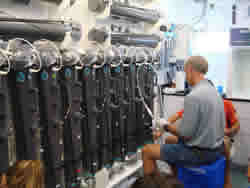- Resources
- Portals and links
- GEOTRACES
- Project overview
In this section
Project overview

The first large-scale investigation of trace elements and their isotopes took place during the 1970s, through the Geochemical Ocean Section Study (GEOSECS). The success of this pioneering programme highlighted the benefits of a global specialist consortium. However, since GEOSECS, there have only been isolated studies on individual metals.
Some 30 years on, oceanographers ability to sample and measure trace metals in water has significantly improved, with clean, contaminant-free sampling procedures and increased sensitivity of analytical instrumentation. With these advancements in metal chemistry there was a growing belief that a new global study of trace elements and their isotopes (TEI) would help the science community understand past, present and future cycles of metals.
In 2003, 85 scientists from 15 countries assembled in France to discuss a new global study to measure and model TEIs; GEOTRACES was born.
The GEOTRACES mission is:
To identify processes and quantify fluxes that control the distribution of key trace elements and isotopes in the ocean, and to establish the sensitivity of these distributions to changing environmental conditions.
Three overriding goals support the GEOTRACES mission
- To determine global ocean distributions of selected trace elements and isotopes, including their concentration, chemical speciation, and physical form, and to evaluate the sources, sinks, and internal cycling of these species and thereby characterise more completely the physical, chemical and biological processes regulating their distribution.
- To understand the processes involved in ocean trace element cycles sufficiently well that the response of these cycles to global change can be predicted, and their impact on the carbon cycle and climate understood.
- To understand the processes that control the concentrations of geochemical species used for proxies of the past environment, both in the water column and in the substrates that reflect the water column.


